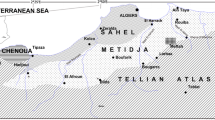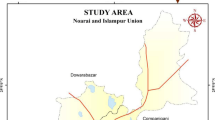Abstract
Despite all the economic benefits of cement production, heavy metals as the byproduct of the cement manufacturing process can be serious threats to the environment and human health. In southwest Iran, the Shiraz cement factory has been in operation since 1979. To date, no biomonitoring effort has been completed to study the extent of heavy metals pollution in the region. Therefore, we began measuring the concentration of heavy metals accumulated in the leaves of four domestic plant species, i.e., Platanus occidentalis L. (sycamore), Salix babylonica (willow), Acer (maple), and Eucalyptus (myrtle). The samples were collected along the radial distances of 1.0–3.0 km from the factory during the spring and summer of 2014. We found that the concentrations of lead (Pb), chromium (Cr), copper (Cu), zinc (Zn), manganese (Mn), and cadmium (Cd) in the plant leaves exceeded the permissible limits for heavy metals. The analysis indicated that the concentrations of heavy metals increased from spring to summer and decreased with distance from the factory. Despite Pb and Cr, the concentrations of Mn, Cu, Zn, and Cd indicated strong dependencies with changes in precipitation, wind speed and direction, temperature, and evapotranspiration. Although Platanus occidentalis L. (sycamore) and Eucalyptus (myrtle) indicated the highest heavy metals accumulation rates compared to Salix babylonica (willow) and Acer (maple), the efficiency of plants to absorb pollution was highly dependent on dominant wind direction and distance from the factory. In dominant wind directions of northwest and west, the absorption rate was not as high as the nondominant wind directions and heavy metals most likely traveled farther than 3.0 km. The current investigation highlights the advantages of biomonitoring deciduous forests and studying the long-term bioaccumulation of heavy metals during one-year growth. Since the exposure time and absorption conditions among similar plant species were constant, the changes in heavy metals concentrations reflected the influence of distance and wind direction. This helps environmental managers to develop sustainable measures for controlling heavy metals pollution in industrial regions by planting certain tree species but within an appropriate distance and direction from the pollution source.









Similar content being viewed by others
Data availability
The data that support the findings of this study are not openly available since the authors personally funded this research effort. The data will be available from the corresponding author upon reasonable request on a secure online data storage platform.
References
Atsdr.cdc.gov. (2011) Agency for Toxic Substances and Disease Registry. [online] Available at: https://www.atsdr.cdc.gov/
Arif N et al (2016) Influence of high and low levels of plant-beneficial heavy metal ions on plant growth and development. Front Environ Sci. https://doi.org/10.3389/fenvs.2016.00069
Bothe H, Słomka A (2017) Divergent biology of facultative heavy metal plants. J Plant Physiol 219:45–61. https://doi.org/10.1016/j.jplph.2017.08.014
Chakrabortty S, Paratkar GT (2006) Biomonitoring of trace element air pollution using mosses. Aerosol Air Qual Res 6(3):247–258. https://doi.org/10.4209/aaqr.2006.09.0002
Eltrop L et al (1991) Lead tolerance of Betula and Salix in the mining area of Mechernich/Germany. Plant Soil 131(2):275–285. https://doi.org/10.1007/BF00009459
Filipovi R (2012) The potential of different plant species for heavy metals accumulation and distribution. J Food Agric Environ 10(1):959–964
Gallo L et al (2014) Element concentrations in the lichen Pseudevernia furfuracea (L.) Zopf transplanted around a cement factory (S Italy). Ecol Ind 46:566–574. https://doi.org/10.1016/j.ecolind.2014.07.029
Getis A, Ord JK (1992) The analysis of spatial association by use of distance statistics. Geogr Anal 24(3):189–206. https://doi.org/10.1111/j.1538-4632.1992.tb00261.x
Hajar EWI, Sulaiman AZB, Sakinah AMM (2014) Assessment of heavy metals tolerance in leaves, stems and flowers of Stevia Rebaudiana plant. Procedia Environ Sci 20:386–393. https://doi.org/10.1016/j.proenv.2014.03.049
Hotelling H (1933) Analysis of a complex of statistical variables into principal components. J Educ Psychol 24(6):417–441. https://doi.org/10.1037/h0071325
Hua S et al (2016) Atmospheric emission inventory of hazardous air pollutants from China’s cement plants: temporal trends, spatial variation characteristics and scenario projections. Atmos Environ 128:1–9. https://doi.org/10.1016/j.atmosenv.2015.12.056
Izenman AJ (2008) Modern multivariate statistical techniques. Springer (Springer Texts in Statistics), New York. https://doi.org/10.1007/978-0-387-78189-1
Kaya G, Yaman M (2012) Determination of trace metals in plant leaves as biomonitor of pollution extent by a sensitive STAT-AAS method. Instrum Sci Technol 40(1):61–74. https://doi.org/10.1080/10739149.2011.633146
Klink A et al (2018) A comparative study on macro- and microelement bioaccumulation properties of leaves and bark of Quercus Petraea and Pinus sylvestris. Arch Environ Contam Toxicol 74(1):71–79. https://doi.org/10.1007/s00244-017-0439-0
Konieczyński P, Wesołowski M (2015) Phosphorus, iron, manganese, zinc and copper in relationto total flavonoids in medicinal herbs and their infusions originating from Poland, Lithuania and Ukraine. Environ Prot Nat Resour 26(4):4. https://doi.org/10.1515/OSZN-2015-0024
Krall JR et al (2017) Associations between source-specific fine particulate matter and emergency department visits for respiratory disease in Four U.S. cities. Environ Health Perspect 125(1):97–103. https://doi.org/10.1289/EHP271
Kuddus M, Kumari R, Ramteke PW (2011) Studies on air pollution tolerance of selected plants in Allahabad city, India. J Environ Res Manag 2(3):042–046
Kumar SS et al (2008) Impact of dust emission on plant vegetation in the vicinity of cement plant. Environ Eng Manag J 7(1):31–35. https://doi.org/10.30638/eemj.2008.006
Liang J et al (2017) Spatial distribution and source identification of heavy metals in surface soils in a typical coal mine city Lianyuan, China. Environ Pollution 225:681–690. https://doi.org/10.1016/j.envpol.2017.03.057
Lorenc-Plucińska G, Walentynowicz M, Niewiadomska A (2013) Capabilities of alders (Alnus incana and A. glutinosa) to grow in metal-contaminated soil. Ecol Eng 58:214–227. https://doi.org/10.1016/j.ecoleng.2013.07.002
Ludovici GM et al (2020) Adaptation to ionizing radiation of higher plants: from environmental radioactivity to chernobyl disaster. J Environ Radioact 222:106375. https://doi.org/10.1016/j.jenvrad.2020.106375
Madejon P, Maranon T, Mmurillo J (2006) Biomonitoring of trace elements in the leaves and fruits of wild olive and holm oak trees. Sci Total Environ 355(1–3):187–203. https://doi.org/10.1016/j.scitotenv.2005.02.028
Mankovská B et al (2004) Chemical and morphological characteristics of key tree species of the Carpathian Mountains. Environ Pollut 130(1):41–54
McGladdery C et al (2018) Elemental assessment of vegetation via portable X-ray fluorescence (PXRF) spectrometry. J Environ Manag 210:210–225. https://doi.org/10.1016/j.jenvman.2018.01.003
Moacă E-A et al (2018) A comparative study of Melissa officinalis leaves and stems ethanolic extracts in terms of antioxidant cytotoxic, and antiproliferative potential. Evid-Based Complement Altern Med. https://doi.org/10.1155/2018/7860456
Mutlu S (2009) Effect of cement dust on diversity and antioxidant enzyme activities of plants growing around a cement factory. Fresenius Environ Bull 18(10):6
Nowak DJ, Crane DE, Stevens JC (2006) Air pollution removal by urban trees and shrubs in the United States. Urban for Urban Green 4(3–4):115–123. https://doi.org/10.1016/j.ufug.2006.01.007
Okedeyi OO et al (2014) Assessing the enrichment of heavy metals in surface soil and plant (Digitaria eriantha) around coal-fired power plants in South Africa. Environ Sci Pollut Res 21(6):4686–4696. https://doi.org/10.1007/s11356-013-2432-0
Olowoyo JO (2015) Trace metals in soil and plants around a cement factory in Pretoria, South Africa. Pol J Environ Stud 24:2087–2093. https://doi.org/10.15244/pjoes/43497
Ord JK, Getis A (1995) Local spatial autocorrelation statistics: distributional issues and an application. Geogr Anal 27(4):286–306. https://doi.org/10.1111/j.1538-4632.1995.tb00912.x
Pająk M, Halecki W, Gąsiorek M (2017) Accumulative response of Scots pine (Pinus sylvestris L.) and silver birch (Betula pendula Roth) to heavy metals enhanced by Pb-Zn ore mining and processing plants: explicitly spatial considerations of ordinary kriging based on a GIS approach. Chemosphere 168:851–859. https://doi.org/10.1016/j.chemosphere.2016.10.125
Pająk M et al (2018) Restoration of vegetation in relation to soil properties of spoil heap heavily contaminated with heavy metals. Water Air Soil Pollut 229(12):392. https://doi.org/10.1007/s11270-018-4040-6
Pearson K (1901) On lines and planes of closest fit to systems of points in space. Philos Mag Ser 2(11):559–572. https://doi.org/10.1080/14786440109462720
Pehluvan M, Turan M, Kaya T (2015) Heavy metal and mineral levels of some fruit species grown at the roadside in the east part of Turkey. Fresenius Environ Bull 24(4):9
Pourrut B, Shahid M, Dumat C, Winterton P, Pinelli E (2011) Lead uptake, toxicity, and detoxification in plants. In: Whitacre DM (ed) Reviews of environmental contamination and toxicology, vol 213. Springer New York, New York, NY, pp 113–136. https://doi.org/10.1007/978-1-4419-9860-6_4
Pytlakowska K et al (2012) Multi-element analysis of mineral and trace elements in medicinal herbs and their infusions. Food Chem 135(2):494–501. https://doi.org/10.1016/j.foodchem.2012.05.002
R Core Team (2020) R: a language and environment for statistical computing. Vienna, Austria: r foundation for statistical computing. Available at: https://www.R-project.org/.
Roque-Álvarez I et al (2018) Spatial distribution, mobility and bioavailability of arsenic, lead, copper and zinc in low polluted forest ecosystem in North-western Mexico. Chemosphere 210:320–333. https://doi.org/10.1016/j.chemosphere.2018.07.004
Rovira J et al (2016) Alternative fuel implementation in a cement plant: human health risks and economical valuation. Arch Environ Contam Toxicol 71(4):473–484. https://doi.org/10.1007/s00244-016-0308-2
Sawidis T et al (2011) Trees as bioindicator of heavy metal pollution in three European cities. Environ Pollut 159(12):3560–3570. https://doi.org/10.1016/j.envpol.2011.08.008
Shah K et al (2018) Impact assessment of leaf pigments in selected landscape plants exposed to roadside dust. Environ Sci Pollut Res 25(23):23055–23073. https://doi.org/10.1007/s11356-018-2309-3
Shen ZJ et al (2017) Heavy metals translocation and accumulation from the rhizosphere soils to the edible parts of the medicinal plant Fengdan (Paeonia ostii) grown on a metal mining area China. Ecotoxicol Environ Saf 143:19–27. https://doi.org/10.1016/j.ecoenv.2017.04.042
Simon E et al (2014) Elemental concentrations in deposited dust on leaves along an urbanization gradient. Sci Total Environ 490:514–520. https://doi.org/10.1016/j.scitotenv.2014.05.028
Siqueira-Silva AI et al (2016) Impact of cement dust pollution on Cedrela fissilis Vell. (Meliaceae): a potential bioindicator species. Chemosphere 158:56–65. https://doi.org/10.1016/j.chemosphere.2016.05.047
Tchounwou PB, Yedjou CG, Patlolla AK, Sutton DJ (2012) Heavy metal toxicity and the environment. In: Luch A (ed) Molecular, clinical and environmental toxicology: volume 3: environmental toxicology. Springer Basel, Basel, pp 133–164. https://doi.org/10.1007/978-3-7643-8340-4_6
Tian Y, Booij MJ, Xu Y-P (2014) Uncertainty in high and low flows due to model structure and parameter errors. Stoch Env Res Risk Assess 28(2):319–332. https://doi.org/10.1007/s00477-013-0751-9
Wickham H (2016) ggplot2: elegant graphics for data analysis. Springer International Publishing, Cham
Yanan W, Liu J, Zhai J, Ling Cong Y, Wang WM, Zhang Z, Li C (2018) Comparison of dry and wet deposition of particulate matter in near-surface waters during summer. PLoS ONE 13(6):e0199241. https://doi.org/10.1371/journal.pone.0199241
Yin S et al (2011) Quantifying air pollution attenuation within urban parks: an experimental approach in Shanghai, China. Environ Pollut 159(8–9):2155–2163. https://doi.org/10.1016/j.envpol.2011.03.009
Zaier H et al (2010) Induced lead binding phytochelatins in Brassica juncea and Sesuvium portulacastrum investigated by orthogonal chromatography inductively coupled plasma-mass spectrometry and matrix assisted laser desorption ionization-time of flight-mass spectrometry. Anal Chim Acta 671(1):48–54. https://doi.org/10.1016/j.aca.2010.04.054
Zhou Y-Q, Huang S-Z, Shi-Long Y, Ji-Guang G, Zhao J-Z, Han Y-L, Jia-Jia F (2009) The physiological response and sub-cellular localization of lead and cadmium in Iris pseudacorus L. Ecotoxicology 19(1):69–76. https://doi.org/10.1007/s10646-009-0389-z
Zimwara, D., Mugwagwa, L. and Chikowore, T.R. (2012) Air pollution control techniques for the cement manufacturing industry: a case study for Zimbabwe, South Africa, p. 13
Acknowledgements
The authors would like to extent their special gratitudes to the associate editor and four anonymous reviewers for their insightful review, valuable comments and suggestions to improve this manuscript.
Author information
Authors and Affiliations
Corresponding author
Ethics declarations
Conflict of interest
The authors declare that they have no known competing financial interests or personal relationships that could have appeared to influence the work reported in this paper. Any opinions, findings, and conclusions or recommendations expressed in this material are those of the author(s) and do not necessarily reflect the views of the entities they are affiliated with.
Additional information
Editorial responsibility: Samareh Mirkia.
Rights and permissions
About this article
Cite this article
Javanmardi, E., Javanmardi, M. & Berton, R. Biomonitoring efforts to evaluate the extent of heavy metals pollution induced by cement industry in Shiraz, Iran. Int. J. Environ. Sci. Technol. 19, 11711–11728 (2022). https://doi.org/10.1007/s13762-022-04307-4
Received:
Revised:
Accepted:
Published:
Issue Date:
DOI: https://doi.org/10.1007/s13762-022-04307-4




